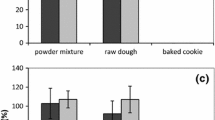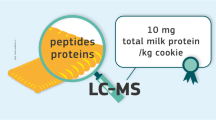Abstract
The design and production of incurred test materials are critical for the development and validation of methods for food allergen analysis. This is because production and processing conditions, together with the food matrix, can modify allergens affecting their structure, extractability and detectability. For the ThRAll project, which aims to develop a mass spectrometry–based reference method for the simultaneous accurate quantification of six allergenic ingredients in two hard to analyse matrices. Two highly processed matrices, chocolate bars and broth powder, were selected to incur with six allergenic ingredients (egg, milk, peanut, soy, hazelnut and almond) at 2, 4, 10 and 40 mg total allergenic protein/kg food matrix using a pilot-scale food manufacturing plant. The allergenic activity of the ingredients incurred was verified using food-allergic patient serum/plasma IgE, the homogeneity of the incurred matrices verified and their stability at 4 °C assessed over at least 30-month storage using appropriate enzyme-linked immunosorbent assays (ELISA). Allergens were found at all levels from the chocolate bar and were homogenously distributed, apart from peanut and soy which could only be determined above 4 mg total allergenic ingredient protein/kg. The homogeneity assessment was restricted to analysis of soy, milk and peanut for the broth powder but nevertheless demonstrated that the allergens were homogeneously distributed. All the allergens tested were found to be stable in the incurred matrices for at least 30 months demonstrating they are suitable for method development.
Graphical abstract








Similar content being viewed by others
References
Commission Directive 2007/68/EC (27 November 2007) amending annex IIIa to Directive 2000/13/EC of the European parliament and of the Council as regards certain food ingredients. Official Journal of the European Union L310/1–4.
Mills ENC, Valovirta E, Madsen C, Taylor SL, Vieths S, Anklam E, Baumgartner S, Koch P, Crevel RWR, Frewer L. Information provision for allergic consumers-where are we going with food allergen labelling ? Allergy. 2004;59:1262–8.
Blom WM, Michelsen-Huisman AD, van Os-Medendorp H, et al. Accidental food allergy reactions: products and undeclared ingredients. J Allergy Clin Immunol. 2018;142(3):865–75.
DunnGalvin A, Chan CH, Crevel R, et al. Precautionary allergen labelling: perspectives from key stakeholder groups. Allergy. 2015;70(9):1039–51.
DunnGalvin A, Roberts G, Schnadt S, et al. Evidence-based approaches to the application of precautionary allergen labelling: report from two iFAAM workshops. Clin Exp Allergy. 2019;49(9):1191–200.
Walker MJ, Burns DT, Elliott CT, Gowland MH, Mills EN. Is food allergen analysis flawed? Health and supply chain risks and a proposed framework to address urgent analytical needs. Analyst. 2016;141(1):24–35.
Mills ENC, Adel-Patient K, Bernard H, De Loose M, Gillard N, Huet A-C, Larré C, Nitride C, Pilolli R, Tranquet O, Van Poucke C, Monaci L. Detection and quantification of allergens in foods and minimum eliciting doses in food-allergic individuals (ThRAll). J AOAC Int. 2019. https://doi.org/10.5740/jaoacint.19-0063.
Pilolli R, Nitride C, Gillard N, Huet A-C, Van Poucke C, De Loose M, Tranquet O, Larré C, Adel-Patient K, Bernard H, Mills ENC, Monaci L. Critical review on proteotypic marker tracing for 6 allergenic ingredients in incurred foods by mass spectrometry. Food Res Int. 2020;128:108747–70.
Pilolli R, Van Poucke C, De Angelis E, Nitride C, De Loose M, Gillard N, Huet A-C, Tranquet O, Larré C, Adel-Patient K, Bernard H, Mills C. Monaci L Discovery based high resolution MS/MS analysis for allergen markers selection in chocolate and broth powder. Food Chem. 2021. https://doi.org/10.1016/j.foodchem.2020.128533.
Taylor SL, Nordlee JA, Niemann LM, Lambrecht DM. Allergen immunoassays – considerations for use of naturally incurred standards. Anal Bioanal Chem. 2009;395(1):83–92.
Mattarozzi M, Careri M. The role of incurred materials in method development and validation to account for food processing effects in food allergen analysis. Anal Bioanal Chem. 2019;411(19):4465–80.
FAO/ INFOODS (2012) FAO/ INFOODS Guidelines for Converting Units, Denominators and Expressions, version 1.0
Bernard H, Paty E, Mondoulet L, Burks AW, Bannon GA, Wal JM, Scheinmann P. Serological characteristics of peanut allergy in children. Allergy. 2003;58(12):1285–92.
Brossard C, Rancé F, Drouet M, Paty E, Juchet A, Guérin C, Pasco M, Tranquet O, Nau F, Denery S. Relative reactivity to egg white and yolk or change upon heating as markers for baked egg tolerance. Pediatr Allergy Immunol. 2019. https://doi.org/10.1111/pai.13009.
Bernard H, Turner PJ, Ah-Leung S, Ruiz-Garcia M, Mills ENC, Adel-Patient K. Circulating Ara h 6 as a marker of peanut protein absorption in tolerant and allergic humans following ingestion of peanut-containing foods. Clin Exp Allergy. 2020;50:1093–102.
Di Stasio L, D’Acierno A, Picariello G, Ferranti P, Nitride C, Mamone G. In vitro gastroduodenal and jejunal brush border membrane digestion of raw and roasted tree nuts. Food Res Int. 2020, 136:109597
De Angelis E, Bavaro S, Monaci L, Pilolli R. Effects of the varietal diversity and the thermal treatment on the protein profile of peanuts and hazelnuts. J of Food Quality. 2018. https://doi.org/10.1155/2018/7635957.
Blanc F, Bernard H, Ah-Leun S, Przybylski-Nicaise L, Skov P, Purohit A, Blay F, Ballmer-Weber B, Fritsche P, Rivas MF, Reig I, Sinaniotis A, Vassilopoulou E, Hoffmann-Sommergruber K, Vieths S, Rigby N, Mills C, Adel-Patient K. Further studies on the biological activity of hazelnut allergens. Clinical and Translational Allergy. 2015. https://doi.org/10.1186/s13601-015-0066-7.
Villa C, Cosat J, Oliveira MB, Mafra I. Bovine milk allergens: a comprehensive review. Comprehensive Reviews in Food Science and Food Safety. 2018;17:137–64.
Bernard H, Hazebrouck S, Gaiani N, Adel-patient K. Allergen risk assessment for specific allergy to small ruminant’s milk: development of sensitive immunoassays to detect goat’s and sheep’s milk contaminations in dairy food matrices. Front Allergy. 2021. https://doi.org/10.3389/falgy.2021.733875.
Fearn T, Thompson M. A new test for ‘sufficient homogeneity.’ Analyst. 2001;126:1414–7.
Ulrich JC, De Souza Sarkis JE. Estimation of uncertainty to the homogeneity study in the certification of a candidate certified reference material in fish matrix. 16th International Congress of Metrology, 16002, 2013. https://doi.org/10.1051/metrology/201316002
Thompson M. Test for “sufficient homogeneity” in a reference material. AMC technical briefs recommendation, 2008, Royal Society of Chemistry: ISSN 1757–5958.23
Mackie A, Knulst A, Le TM, Bures P, Salt L, Mills EN, Malcolm P, Andreou A, Ballmer-Weber BK. High fat food increases gastric residence and thus thresholds for objective symptoms in alleric patients. Mol Nutr Food Res. 2012;56(11):1708–14.
Ballmer-Weber BK, Fernandez-Rivas M, Beyer K, et al. How much is too much? Threshold dose distributions for 5 food allergens. J Allergy Clin Immunol. 2015;135(4):964–71.
Willison LN, Zhang Q, Su M, Teuber S, Sathe SK, Roux KH. Conformational epitope mapping of Pru du 6, a major allergen from almond nut. Mol Immunol. 2013;55(3–4):253–63. https://doi.org/10.1016/j.molimm.2013.02.004.
Docena GH, Fernandez R, Chirdo FG, Fossati CA. Identification of casein as the major allergenic and antigenic protein of cow’s milk. Allergy. 1996;51(6):412–6.
Wise S, Sharpless K, Sander L, May W. Standard Reference Materials to support US regulations for nutrients and contaminants in food and dietary supplements. Accredit Qual Assur. 2004. https://doi.org/10.1007/s00769-004-0820-3.
Khuda SE, Jackson LS, Fu T-J, Williams KM. Effects of processing on the recovery of food allergens from a model dark chocolate matrix. Food Chem. 2015. https://doi.org/10.1016/j.foodchem.2014.07.084.
Khuda S, Slate A, Pereira M, Al-Taher F, Jackson L, Diaz-Amigo C, Bigley EC, Whitaker T, Williams K. Effect of processing on recovery and variability associated with immunochemical analytical methods for multiple allergens in a single matrix: dark chocolate. J Agric Food Chem. 2012. https://doi.org/10.1021/jf3001845.
Gu S, Chen N, Zhou Y, Zhao C, Zhan L, Qu L, Cao C, Han L, Deng X, Ding T, Song C, Ding Y. A rapid solid-phase extraction combined with liquid chromatography-tandem mass spectrometry for simultaneous screening of multiple allergens in chocolates. Food Control. 2018. https://doi.org/10.1016/j.foodcont.2017.07.033.
Bignardi C, Mattarozzi M, Penna A, Sidoli S, Elviri L, Careri M, Mangia A. A rapid size-exclusion solid-phase extraction step for enhanced sensitivity in multi-allergen determination in dark chocolate and biscuits by liquid chromatography-tandem mass spectrometry. Food Anal Methods. 2013. https://doi.org/10.1007/s12161-012-9521-4.
Nitride C, Lee V, Baricevic-Jones I, Adel-Patient K, Baumgartner S, Mills ENC. Integrating allergen analysis within a risk assessment framework: approaches to development of targeted mass spectrometry methods for allergen detection and quantification in the iFAAM project. J AOAC Int. 2018. https://doi.org/10.5740/jaoacint.17-0393.
Alves RC, Pimentel FB, Nouws HPA, Silva THB, Oliveira MBPP, Delerue-Matos C. Improving the extraction of Ara h 6 (a peanut allergen) from a chocolate-based matrix for immunosensing detection: Influence of time, temperature and additives. Food Chem. 2017. https://doi.org/10.1016/j.foodchem.2016.09.085.
Herman L, De BJ, Viane R. Detection of hazelnut DNA traces in chocolate by PCR. Int J Food Sci Technol. 2003. https://doi.org/10.1046/j.1365-2621.2003.00722.x.
Vadas P, Perelman B. Presence of undeclared peanut protein in chocolate bars imported from Europe. J Food Prot. 2003. https://doi.org/10.4315/0362-028X-66.10.1932.
POMÉS A, VINTON R, CHAPMAN MD. Peanut allergen (Ara h 1) detection in foods containing chocolate. J Food Prot, 2004; https://doi.org/10.4315/0362-028X-67.4.793
Akkerdaas JH, Wensing M, Knulst AC, Stephan O, Hefle SL, Aalberse RC, van Ree R. A novel approach for the detection of potentially hazardous pepsin stable hazelnut proteins as contaminants in chocolate-based food. J Agric Food Chem. 2004. https://doi.org/10.1021/jf049278r.
Korte R, Oberleitner D, Brockmeyer J. Determination of food allergens by LC-MS: Impacts of sample preparation, food matrix, and thermal processing on peptide detectability and quantification. J Proteomics. 2019. https://doi.org/10.1016/j.jprot.2018.11.002.
Costa J, Ansari P, Mafra I, Oliveira MBPP, Baumgartner S. Development of a sandwich ELISA-type system for the detection and quantification of hazelnut in model chocolates. Food Chem. 2015. https://doi.org/10.1016/j.foodchem.2014.10.024.
Ben Rejeb S, Abbott M, Davies D, Cléroux C, Delahaut P. Multi-allergen screening immunoassay for the detection of protein markers of peanut and four tree nuts in chocolate. Food Addit Contam. 2005;22:709–15. https://doi.org/10.1080/02652030500158450.
Scheibe B, Weiss W, Ruëff F, Przybilla B, Görg A. Detection of trace amounts of hidden allergens: hazelnut and almond proteins in chocolate. J Chromatogr B Biomed Sci Appl. 2001;756:229–37. https://doi.org/10.1016/S0378-4347(01)00083-4.
Do AB, Khuda SE, Sharma GM. Undeclared food allergens and gluten in commercial food products analyzed by ELISA. J AOAC Int. 2018;101(1):23–34.
Acknowledgements
The present article is the sole responsibility of the authors. The positions and opinions presented in this article are those of the authors alone and do not necessarily represent the views of any official position or scientific works of EFSA. EFSA guidance documents and other scientific outputs of EFSA can be found in the EFSA website, http://www.efsa.europa.eu. Bert Verlinden, Jari Van De Vijver, Hans Steurbaut, Jurgen Baert, Stijn Degroote and Estelle De Paepe are acknowledged for their practical assistance in the production of the test materials. Emilie Perrin is acknowledged for her technical assistance in IgE binding experiments, Amandine Lamote and Paolo Paque for the analyses of stability by ELISA, Martin Mailleux for the analyses by mass spectrometry. We gratefully thank Gianfranco Mamone and the Luigia di Stasio Institute of Food Sciences – National Research Council, Avellino, Italy – for providing us with the almond and hazelnut reference materials.
Funding
This work has received financial support from the European Food Safety Authority (EFSA) for the ThRAII project GP/EFSA/AFSCO/2017/03. It was also co-funded by the UK Food Standards Agency (FS101209), the Grant FS101206 (UK FSA) for the development of quality control materials for food allergen analysis and the Belgian Federal Agency for the Safety of the Food Chain (FASFC).
Sera or plasma from patients allergic to peanuts, milk, egg, almond, hazelnut or soy was obtained from the Biological Resource Center (BB-0033–00038) of Clinical Immunology and Allergy Service of Angers University Hospital (France) with the informed consent of the patients.
Author information
Authors and Affiliations
Corresponding author
Ethics declarations
Conflict of Interest
The authors declare no competing interests.
Additional information
Publisher's Note
Springer Nature remains neutral with regard to jurisdictional claims in published maps and institutional affiliations.
Supplementary Information
Below is the link to the electronic supplementary material.
Rights and permissions
About this article
Cite this article
Huet, AC., Paulus, M., Henrottin, J. et al. Development of incurred chocolate bars and broth powder with six fully characterised food allergens as test materials for food allergen analysis. Anal Bioanal Chem 414, 2553–2570 (2022). https://doi.org/10.1007/s00216-022-03912-z
Received:
Revised:
Accepted:
Published:
Issue Date:
DOI: https://doi.org/10.1007/s00216-022-03912-z




